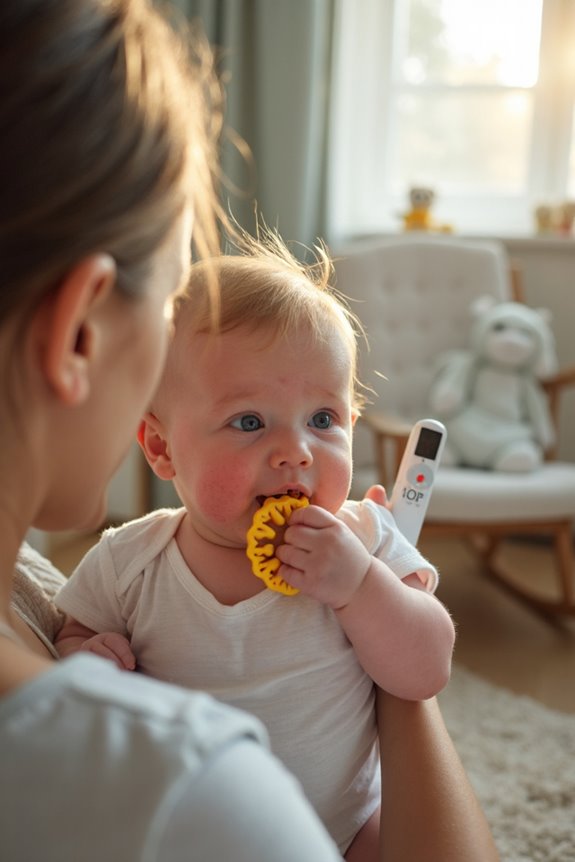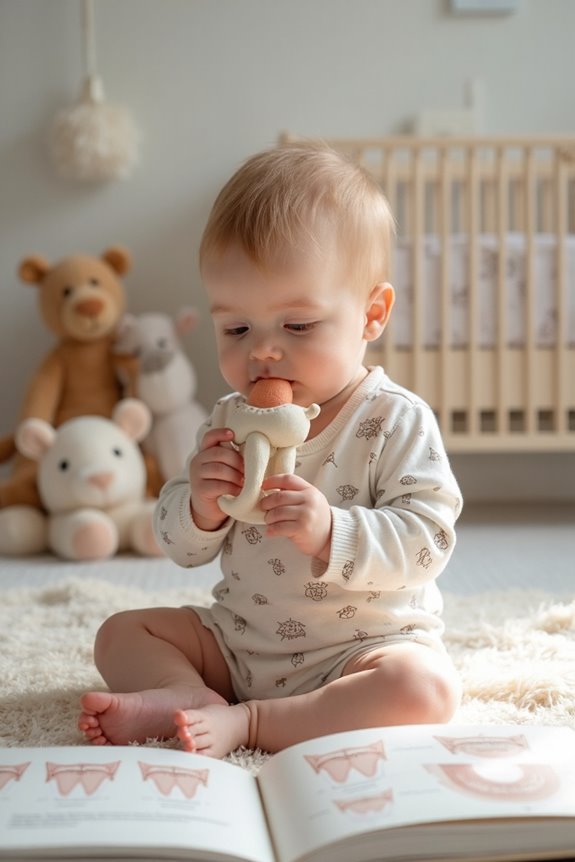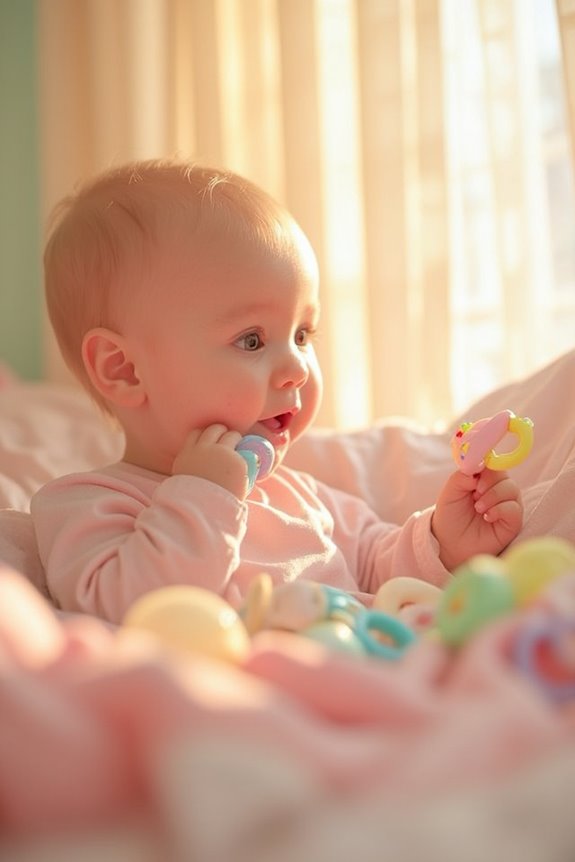While teething can cause slight temperature elevations, it usually doesn’t lead to a fever as high as 103°F. Typically, teething may cause mild symptoms like drooling, irritability, and gum discomfort. A fever of 103°F often suggests an underlying issue, possibly a viral or bacterial infection, rather than teething. It’s important to monitor other symptoms and consult with your healthcare provider to ensure proper care. In exploring further, you’ll uncover more about distinguishing these scenarios.
Key Takeaways
- Teething may cause slight temperature elevation but not a fever above 100.4°F.
- A fever of 103°F is typically not caused by teething.
- High fevers in infants are usually due to infections, not teething.
- Fever during teething may indicate an unrelated illness requiring medical attention.
- Consult a healthcare provider if an infant has a fever of 103°F.
Understanding Normal and Elevated Body Temperatures
Let’s dive into understanding normal and elevated body temperatures, which is essential for keeping an eye on your little one’s health. We know that a normal temperature for infants can range from 97.9°F to 100.2°F rectally. Isn’t it fascinating how temperature fluctuations are quite common due to factors like room temperature and time of day?
- Normal Temperature Range: For newborns, a slightly higher average temperature of 99.5°F is typical due to their metabolic rate.
- Age Variations: As children grow, their normal temperature may settle around 97.52°F.
- Factors Influencing Temperature: Higher activity levels and the environment can cause temporary changes.
Fever Definitions and Age Variations

When it comes to monitoring your little one’s health, understanding what constitutes a fever is key. We know that fever variations can be tricky, especially when considering age. For infants under 3 months, a fever starts at 100.4°F (38°C), and immediate medical attention is advised. Older infants, however, have a slightly higher threshold, generally at 101.2°F (38.4°C).
- Infants under 3 months: Fever is 100.4°F or higher.
- Infants over 3 months: Fever typically starts at 101.2°F.
Teething can cause a slight temperature rise, but not a true fever. Monitoring infant health involves watching for additional symptoms. Always consult a healthcare provider if a fever persists or if your child seems unusually uncomfortable. Stay informed and trust your instincts.
Common Symptoms of Teething

Teething is a milestone that every baby goes through, and while it may seem daunting, understanding the common symptoms can help you navigate this phase with confidence. Let’s explore these signs together and consider how they fit into the teething timeline.
- Fussiness and Irritability: Many babies become cranky, impacting their sleep and your peace.
- Drooling: More than half experience excessive drooling, leading to chin and neck rashes.
- Gum and Ear Rubbing: Babies gnaw on objects and rub gums to ease discomfort, sometimes mistaking ear pain for teething.
- Mild Temperature Elevation: Occasionally, a slight rise in temperature occurs.
Symptom management involves comforting your little one, keeping drool in check, and offering safe objects to chew on.
Distinguishing Between Teething and Fever

How can we tell if a baby’s discomfort is due to teething or an actual fever? Let’s explore the differences together.
First, we should check the temperature. A genuine fever starts at 100.4°F, while teething may cause a slight rise without surpassing this threshold. Keep the teething timeline in mind—typical symptoms include drooling, gum pain, and irritability. Fever symptoms, on the other hand, might follow distinct fever patterns, such as sweating and loss of appetite.
Also, notice if symptoms overlap: irritability can happen with both, but fever tends to make it more intense. Monitoring these signs helps us distinguish between teething and potential illness. Remember, if a fever persists, consulting a healthcare professional is essential for your baby’s well-being.
Causes of High Fever in Infants

As we dive into the causes of high fever in infants, it’s important to remember that such fevers can be a sign of various underlying issues. We often encounter viral infections, like the common cold or flu, which are typical culprits. Bacterial infections, such as urinary tract infections or pneumonia, can also lead to high fevers.
Let’s not forget about other potential causes:
- Immunizations: Can sometimes cause mild fevers.
- Respiratory Infections: Frequent in infants, especially with daycare exposure.
- Environmental Factors: Overheating can result in low-grade fevers.
Monitoring your baby’s symptoms helps us determine the cause. While most fevers are harmless, they can occasionally signal more serious conditions. Staying informed and vigilant is essential for our little ones’ health and well-being.
When to Seek Medical Attention

When should we reach out for medical help if our little one has a fever? Navigating fever patterns and symptom evaluation is crucial. Here’s when to contact a healthcare provider:
- Infants Under 3 Months: A fever over 100.4 F (38 C) needs immediate attention.
- Persistent Fevers: Lasting more than 24 hours? It’s time to see a doctor.
- High Fevers: Above 102 F (39 C) in infants over 3 months requires evaluation.
- Severe Symptoms: Diarrhea, vomiting, or a rash alongside the fever are red flags.
- Medical Emergencies: Fever at 104 F (40 C) or blue lips demand urgent care.
Let’s ensure our baby stays safe by monitoring these concerns closely and seeking help when necessary. We’re all in this together, after all!
Managing Mild Teething Symptoms at Home

Managing mild teething symptoms at home doesn’t have to be a daunting task. We’ve got a variety of natural remedies and soothing techniques to help. Cold remedies, like chilled teething rings or washcloths, can numb sore gums. A gentle gum massage with our clean fingers can ease discomfort, using a circular motion and light pressure.
For those quiet moments, consider offering breastfeeding or a pacifier to provide comfort. Physical touch, like cuddling, also works wonders. Let’s not forget the power of a tranquil bath—it’s a great distraction.
Chilled foods, such as pureed fruits, can provide relief, but always supervise closely. Herbal remedies, like chamomile or diluted clove oil, can also help soothe. Together, we can manage teething with ease.
Dispelling Teething Myths and Misconceptions

Why do so many myths about teething persist despite all the information available? We understand that parental concerns often lead to beliefs in teething myths, seeking comfort in explanations for their baby’s discomfort. Let’s address some misconceptions:
- High Fever: Teething doesn’t cause high fevers. A 103-degree fever could indicate an illness, not teething.
- Appetite Loss: Not all babies lose their appetite due to teething.
- Teething Remedies: Avoid using teething gels due to risks. Opt for safe alternatives like chilled teething rings.
- Diarrhea: No scientific link between teething and diarrhea.
Recognizing accurate teething symptoms helps us provide better care. Remember, drooling and mild gum pain are normal. Consult healthcare professionals when needed to ensure your baby’s wellbeing.
Frequently Asked Questions
What Are Effective Ways to Soothe a Teething Baby?
We know teething can be tough, but let’s soothe our little ones with teething toys and cold compresses. Gently press their gums with a clean finger and keep the room calm. Together, we can ease their discomfort.
Can Teething Affect a Baby’s Sleep Patterns?
Ah, the joys of parenting—teething discomfort, those delightful sleep disturbances! We all know teething can turn our precious sleep schedules into a circus. Let’s stick together and tackle those midnight wake-ups with soothing strategies and understanding.
Are There Any Specific Foods to Avoid During Teething?
We know teething’s tough, but let’s skip hard or sticky foods. They can make it worse. Instead, try soothing techniques like soft, cold foods or teething gels. These teething remedies can bring comfort to our little ones.
How Long Does the Teething Process Usually Last?
We know you’re curious about the teething duration. Typically, teething lasts from 6 to 24 months. We’ll notice signs of teething like drooling and fussiness as each tooth emerges. Let’s navigate this together.
Can Teething Cause Changes in Bowel Movements?
We’ve noticed teething symptoms may coincide with changes in bowel consistency. While it’s not a definitive link, some babies experience loose stools. Let’s watch for diet or illness as potential causes too. We’re here for you.




